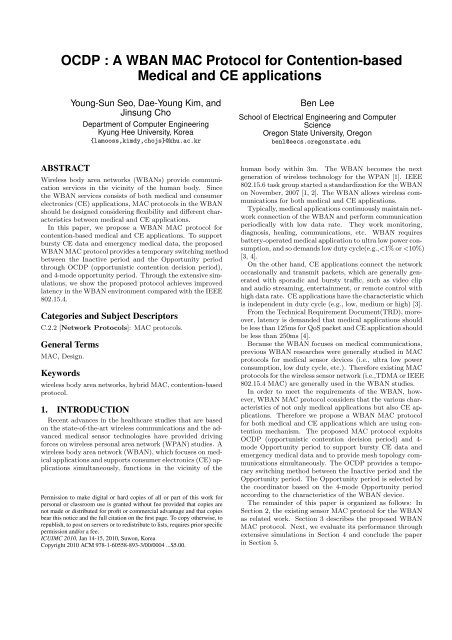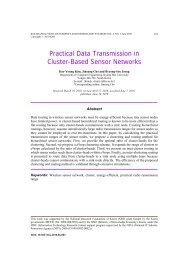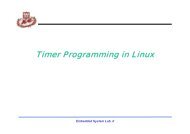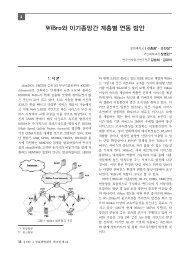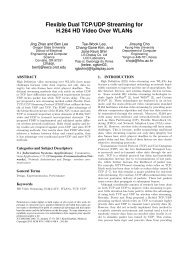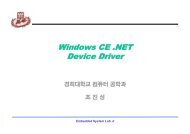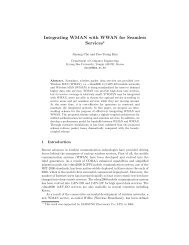OCDP : A WBAN MAC Protocol for Contention-based Medical and ...
OCDP : A WBAN MAC Protocol for Contention-based Medical and ...
OCDP : A WBAN MAC Protocol for Contention-based Medical and ...
- No tags were found...
Create successful ePaper yourself
Turn your PDF publications into a flip-book with our unique Google optimized e-Paper software.
<strong>OCDP</strong> : A <strong>WBAN</strong> <strong>MAC</strong> <strong>Protocol</strong> <strong>for</strong> <strong>Contention</strong>-<strong>based</strong><strong>Medical</strong> <strong>and</strong> CE applicationsYoung-Sun Seo, Dae-Young Kim, <strong>and</strong>Jinsung ChoDepartment of Computer EngineeringKyung Hee University, Korea{lamooss,kimdy,chojs}@khu.ac.krBen LeeSchool of Electrical Engineering <strong>and</strong> ComputerScienceOregon State University, Oregonbenl@eecs.oregonstate.eduABSTRACTWireless body area networks (<strong>WBAN</strong>s) provide communicationservices in the vicinity of the human body. Sincethe <strong>WBAN</strong> services consists of both medical <strong>and</strong> consumerelectronics (CE) applications, <strong>MAC</strong> protocols in the <strong>WBAN</strong>should be designed considering flexibility <strong>and</strong> different characteristicsbetween medical <strong>and</strong> CE applications.In this paper, we propose a <strong>WBAN</strong> <strong>MAC</strong> protocol <strong>for</strong>contention-<strong>based</strong> medical <strong>and</strong> CE applications. To supportbursty CE data <strong>and</strong> emergency medical data, the proposed<strong>WBAN</strong> <strong>MAC</strong> protocol provides a temporary switching methodbetween the Inactive period <strong>and</strong> the Opportunity periodthrough <strong>OCDP</strong> (opportunistic contention decision period),<strong>and</strong> 4-mode opportunity period. Through the extensive simulations,we show the proposed protocol achieves improvedlatency in the <strong>WBAN</strong> environment compared with the IEEE802.15.4.Categories <strong>and</strong> Subject DescriptorsC.2.2 [Network <strong>Protocol</strong>s]: <strong>MAC</strong> protocols.General Terms<strong>MAC</strong>, Design.Keywordswireless body area networks, hybrid <strong>MAC</strong>, contention-<strong>based</strong>protocol.1. INTRODUCTIONRecent advances in the healthcare studies that are <strong>based</strong>on the state-of-the-art wireless communications <strong>and</strong> the advancedmedical sensor technologies have provided driving<strong>for</strong>ces on wireless personal area network (WPAN) studies. Awireless body area network (<strong>WBAN</strong>), which focuses on medicalapplications <strong>and</strong> supports consumer electronics (CE) applicationssimultaneously, functions in the vicinity of thePermission to make digital or hard copies of all or part of this work <strong>for</strong>personal or classroom use is granted without fee provided that copies arenot made or distributed <strong>for</strong> profit or commercial advantage <strong>and</strong> that copiesbear this notice <strong>and</strong> the full citation on the first page. To copy otherwise, torepublish, to post on servers or to redistribute to lists, requires prior specificpermission <strong>and</strong>/or a fee.ICUIMC 2010, Jan 14-15, 2010, Suwon, KoreaCopyright 2010 ACM 978-1-60558-893-3/00/0004 ...$5.00.human body within 3m. The <strong>WBAN</strong> becomes the nextgeneration of wireless technology <strong>for</strong> the WPAN [1]. IEEE802.15.6 task group started a st<strong>and</strong>ardization <strong>for</strong> the <strong>WBAN</strong>on November, 2007 [1, 2]. The <strong>WBAN</strong> allows wireless communications<strong>for</strong> both medical <strong>and</strong> CE applications.Typically, medical applications continuously maintain networkconnection of the <strong>WBAN</strong> <strong>and</strong> per<strong>for</strong>m communicationperiodically with low data rate. They work monitoring,diagnosis, healing, communications, etc. <strong>WBAN</strong> requiresbattery-operated medical application to ultra low power consumption,<strong>and</strong> so dem<strong>and</strong>s low duty cycle(e.g.,
Figure 2: The proposed <strong>WBAN</strong> <strong>MAC</strong> protocolFigure 1: Superframe structure in IEEE 802.15.42. RELATED WORKSince medical applications are the major issues of the<strong>WBAN</strong>, existing <strong>WBAN</strong> <strong>MAC</strong> protocol (i.e., TDMA <strong>and</strong>IEEE 802.15.4) have been proposed <strong>for</strong> medical applications.TDMA was studied in early stage of <strong>WBAN</strong> researcheswhich consist of the medical sensor devices [5, 6]. When a<strong>WBAN</strong> consists of various devices with different characteristics(e.g., medical or entertainment characteristics), TDMAmay not be adequate.IEEE 802.15.4 <strong>MAC</strong> [7] protocol, which is st<strong>and</strong>ard <strong>for</strong>wireless sensor networks, is considered <strong>for</strong> the <strong>WBAN</strong> [8,9]. IEEE 802.15.4 <strong>MAC</strong> uses a superframe structure in abeacon-enabled mode as shown in Figure 1. The superframeduration (SD) as an active period is divided into 16 equalsizedtime slots. A guaranteed time slot (GTS) is allocatedin one or more slots to a device. If lots of GTS slots are allocated,a contention access period (CAP) is decreased. Inaddition, the GTS of IEEE 802.15.4 allows at most 7 devices.In general, IEEE 802.15.4 needs more CAP slots sothat a coordinator may increase a value of SO <strong>for</strong> the extensionof the CAP duration. By increasing superframe order(SO), however, the GTS slots also increases together. Thus,unnecessary increase of the size of GTS slots exponentially.Since the medical application is the focus of the <strong>WBAN</strong>,as we identified in Section 1, existing <strong>MAC</strong> protocols aregenerally used in the <strong>WBAN</strong>. In <strong>WBAN</strong> environments, however,CE devices may generate bursty data with event-drivenmethods <strong>and</strong> connect with the <strong>WBAN</strong> occasionally. Thus,existing <strong>MAC</strong> protocols using periodic sleep method <strong>for</strong> lowpower consumption have the latency due to the periodicsleep. That is, since existing <strong>MAC</strong> protocols are designed <strong>for</strong>sensor devices required low power consumption, the <strong>WBAN</strong><strong>MAC</strong> protocol should be designed <strong>for</strong> both medical <strong>and</strong> CEapplications flexibly.3. PROPOSED <strong>WBAN</strong> <strong>MAC</strong> PROTOCOLAs mentioned earlier, since providing the flexibility <strong>for</strong>various applications is the main goal, we propose a hybrid superframestructure <strong>MAC</strong> protocol <strong>for</strong> the <strong>WBAN</strong>. As shownin Figure 2, the proposed <strong>WBAN</strong> <strong>MAC</strong> protocol focuses onthe following ideas:First, we exploit the <strong>OCDP</strong> <strong>for</strong> the flexible ranges of thelatency. In IEEE 802.15.4, the Inactive period is determinedby beacon order (BO) <strong>and</strong> SO in a beacon <strong>and</strong> all devicessleep in the Inactive period. If CAP is insufficient due toincreased temporary traffics, IEEE 802.15.4 exp<strong>and</strong>s CAPby increasing SO in a beacon. However, if SO increases,the size of GTS slots also exponentially increases as shownin Figure. 1. To support the <strong>WBAN</strong> devices required latency<strong>and</strong> the sporadic traffics of CE applications flexibly,the <strong>OCDP</strong> is proposed.Second, we exploit the 4-mode Opportunity period.The 4-mode Opportunity period has 4 kinds of design patterns<strong>for</strong> the Opportunity period. <strong>WBAN</strong> devices requestthe Opportunity period through transmitting the OCM(opportunity contention message) frame in the subperiodof RO (request or opportunity) in the <strong>OCDP</strong>.The coordinator selectively decides the Opportunity periodamong the 4-mode Opportunity period, <strong>and</strong> then the coordinatorbroadcasts a OCM ACK (acknowledgement)frame in the AO (acknowledgement of Opportunity)subperiod in the <strong>OCDP</strong> as shown in Figure 3.3.1 <strong>OCDP</strong> (Opportunistic <strong>Contention</strong> DecisionPeriod)Figure 3 depicts the proposed <strong>OCDP</strong>. Unlike the IEEE802.15.4 <strong>MAC</strong> protocol, the proposed <strong>MAC</strong> protocol hasthe <strong>OCDP</strong>. The coordinator could decide whether the Inactiveperiod or the Opportunity period in the <strong>OCDP</strong>. Whenbursty data increase temporarily, the latency is inevitable inperiodic sleep mechanisms such as the IEEE 802.15.4 <strong>MAC</strong>.In the proposed <strong>MAC</strong> protocol, the <strong>OCDP</strong> provides the opportunities<strong>for</strong> switching from the Inactive period to theOpportunity period.Figure 3: The detailed <strong>OCDP</strong>The <strong>OCDP</strong> consists of both the RO subperiod <strong>and</strong> theAO subperiod. To use those of subperiods, the proposed<strong>WBAN</strong> <strong>MAC</strong> protocol provides two request frames namedOCM <strong>and</strong> OCM ACK. The <strong>WBAN</strong> devices may request theOpportunity period through transmitting the OCM frame tothe coordinator. On the other h<strong>and</strong>, the coordinator broadcaststhe OCM ACK frame including the selected Opportunityperiod among the 4-mode Opportunity period.The RO subperiod is designed <strong>for</strong> transmitting the OCM
Table 1: Table of RONumber of RORO 1RO 2RO 3<strong>WBAN</strong> devices<strong>Medical</strong> devices, sensor, etcCE with slotted CSMA-CACE with CSMA-CA (DCF)(a) Mode ATable 2: Decision Table of Opportunity periodReceived OCM select mode of(RO 1 , RO 2 , RO 3 ) 4-mode Opportunity period0, 0, 0 Inactive period0, 0, 1 Mode C0, 1, 0 Mode B0, 1, 1 Mode D1, 0, 0 Mode A1, 0, 1 Mode D1, 1, 0 Mode B1, 1, 1 Mode D(b) Mode B(b) Mode C(b) Mode DFigure 4: 4-mode Opportunity period.frame. As shown in Figure 3, the RO subperiod has threekinds of subperiods from the RO 1 subperiod to the RO 3subperiod in <strong>OCDP</strong>. As shown in Table 1, these subperiodsare mapped to the <strong>WBAN</strong> devices according to its characteristics.As shown in Table 1, since the RO subperiod isdistinguished into 3 groups, each <strong>WBAN</strong> device issues <strong>and</strong>transmits the OCM frame to the coordinator <strong>for</strong> requestingthe Opportunity period.The AO subperiod is provided <strong>for</strong> transmitting the OC<strong>MAC</strong>K which is a decision message of switching between theInactive period <strong>and</strong> the Opportunity period. Table 2 showsthe decision table of the Opportunity period. If a <strong>WBAN</strong>device transmits the OCM frame, the coordinator receivesthe OCM frame <strong>and</strong> sets the RO n (e.g., RO 1 , RO 2 , or RO 3 )to 1. In case that the value of the RO 1 sets to 1, it meansthat either medical devices or sensor devices transmits theOCM frame. When a CE device generates bursty data, theOCM frame transmitted by the CE device. Thus, the valueof RO 2 sets to 1. Since the IEEE 802.15.4 <strong>MAC</strong> uses theslotted CSMA-CA mechanism <strong>for</strong> sensor devices with lowpower consumption <strong>and</strong> low data rate, the data transmitsto the coordinator without RTS (request to send), CTS(clear to send), <strong>and</strong> NAV(network allocation vector). Forproviding peer to peer communications without relaying tothe coordinator, the proposed <strong>MAC</strong> protocol provides DCFmechanism to the CE devices optionally. These CE devicesrequest the Opportunity period in the RO 3 subperiod. Acoordinator used in the Table 2 decides the one of opportunityperiod among 4-mode opportunity period through compoundingeach OCM frame of RO n.The proposed <strong>OCDP</strong> has additional overhead in comparisonwith the IEEE 802.15.4 <strong>MAC</strong>. Since the medical applicationsgenerally use the Active period, however, they usethe <strong>OCDP</strong> <strong>and</strong> the Opportunity period in the emergency situationor the medical device requiring the latency. Both CEapplications <strong>and</strong> event-driven medical applications (e.g., motiondetection <strong>and</strong> fall detection <strong>for</strong> the elderly or disabledpeople) use the Opportunity period <strong>for</strong> the low latency toresolve bursty data traffic occasionally. There<strong>for</strong>e, the coordinatorusually spends energy to wake-up the system in the<strong>OCDP</strong>.3.2 4-Mode Opportunity PeriodIn <strong>OCDP</strong>, if there is any <strong>WBAN</strong> device which wants touse the Opportunity period, they request the Opportunityperiod through transmitting the OCM frame in the subperiodof RO in the <strong>OCDP</strong>. When all of the subperiods of ROend, the coordinator decides <strong>and</strong> selects the Opportunityperiod among four kinds of Opportunity period as shown inFigure 4. Since each RO is mapped to <strong>WBAN</strong> device characteristics,as shown in Table 1, the coordinator calculates<strong>and</strong> decides the Opportunity period through Table 2.As shown in Figure 3, the Mode A provides the slottedCSMA-CA with periodic sleep alternately <strong>for</strong> low power consumption.Since Mode A means that the medical device onlyrequests the Opportunity period, the all of CE devices sleepduring Mode A. Mode B provides the slotted CSMA-CAduring the Mode B. Mode C provides only DCF mechanismduring the Mode C. Mode D provides both the slottedCSMA-CA <strong>and</strong> the DCF mechanism alternately.4. PERFORMANCE EVALUATIONWe first describe our simulation model to compare theper<strong>for</strong>mance of the proposed <strong>WBAN</strong> <strong>MAC</strong> protocol with theIEEE 802.15.4. We assume following PHY model as wirelesschannel: ISM b<strong>and</strong>, O-QPSK modulation, 2,000kcpschip rate, <strong>and</strong> 250kbps data rate [5]. In addition, both theproposed <strong>and</strong> IEEE 802.15.4 <strong>MAC</strong> protocols use the superframestructure. In order to satisfy the latency requirementin Section 1, we set BO=4 (245.76ms of superframe) <strong>and</strong>SO=3 (122.88ms of active period).Next, the traffic model is as follow: There exists medicaldevices of which the sampling rate is 12 channel electrocardiography(ECG) (250Hz), Temperature (2Hz), Oximetry(60Hz), Breathing rate (50Hz), Skin resistance (50Hz), Arterialpressure (120Hz), Respiration rate (20Hz), Cardiacrate (10hz). The period of packet generation are between
Figure 5: Latency comparison (medical devices)300ms <strong>and</strong> 550ms. They send a packet of 40 bytes periodically[8, 9]. On the other h<strong>and</strong>, one CE device sends amessage of 2000 bytes sporadically. The message is split into<strong>MAC</strong>-layer packets of 127 bytes which is the maximum sizeof IEEE 802.15.4 [5]. The inter-packet interval is 20ms withCBR (constant bit rate) packet generator [10].Figure 5 shows the latency when there exists only medicaldevices. In proposed <strong>MAC</strong> protocol, the medical devicesrequired the low latency are able to use Mode A. Since theproposed <strong>MAC</strong> protocol provides the Opportunity period,the proposed <strong>MAC</strong> protocol increases the latency when thereare more than 35 devices. However, IEEE 802.15.4 usingperiodic sleep increases the latency when there are morethan 20 devices.Figure 6 shows the latency when a CE device is added.The CE device should contend medical devices in CAP inthe Active period. When the CE device generates the burstydata <strong>and</strong> goes to sleep in the Inactive period, the latency isinevitable. However, the CE device can use the Opportunityperiod (i.e., Mode B) in the proposed <strong>MAC</strong> protocol,so that the latency can be reduced dramatically. The proposedprotocol can be used flexibly in a variety of <strong>WBAN</strong>applications as mentioned in Section 1.5. CONCLUSIONIn this paper, we have proposed a <strong>WBAN</strong> <strong>MAC</strong> protocol<strong>for</strong> <strong>WBAN</strong> applications using the contention mechanism.Since our proposed protocol has the <strong>OCDP</strong> <strong>and</strong> 4 mode Opportunityperiod, it can be used flexibly in various <strong>WBAN</strong>devices <strong>and</strong> applications which require low latency. We havevalidated the flexibility through extensive simulations.6. ACKNOWLEDGMENTSThis work was supported by the Korea Science <strong>and</strong> EngineeringFoundation (KOSEF) grant funded by the Koreagovernment (MEST) (No. R01-2008-000-20029-0) <strong>and</strong> bythe MKE (Ministry of Knowledge Economy), Korea, underthe ITRC (In<strong>for</strong>mation Technology Research Center) supportprogram supervised by the NIPA (National IT IndustryPromotion Agency) (NIPA-2009-(C1090-0902-0002)).Figure 6: Latency comparison (with CE device)7. REFERENCES[1] H. B. Li, R. Kohno. Introduction of SG-BAN in IEEE802.15 with related discussion. Proc. IEEE InternationalConference on Ultra Wideb<strong>and</strong>, pp. 134–139, September2007.[2] IEEE 802.15 WPAN Task Group 6 BAN:http://www.ieee802.org/15/pub/TG6.html.[3] 802.15.6 Call <strong>for</strong> Applications - Response Summary,IEEE 802.15-08-0407-05-0006.[4] TG6 Technical Requirements Document (TRD), IEEE802.15-08-0664-09-0006.[5] Omeni. O, Wong. A, Burdett. A. J, <strong>and</strong> Toumazou. C.Energy Efficient Medium Access <strong>Protocol</strong> <strong>for</strong> Wireless<strong>Medical</strong> Body Area Sensor Networks. BiomedicalCircuits <strong>and</strong> Systems, IEEE Transactions on, vol. 2,Issue. 4, pp. 251–259, December 2008.[6] C. Min, P. Chenglin, G. Xingming, L. Jianmei. A Novel<strong>MAC</strong> <strong>Protocol</strong> <strong>for</strong> Wireless Physiological In<strong>for</strong>mationSensor Network. <strong>Medical</strong> Devices <strong>and</strong> Biosensors, 2007.4th IEEE/EMBS International Summer School <strong>and</strong>Symposium on, pp. 79–81, August 2007.[7] IEEE 802.15.4 St<strong>and</strong>ard-2003, “Part 15.4: WirelessMedium Access Control(<strong>MAC</strong>) <strong>and</strong> PhysicalLayer(PHY) Specifications <strong>for</strong> Low-Rate WirelessPersonal Area Networks(LR-WPANs),” 2003[8] Haifeng. C, Wanqing. W, Jungtae. L. A <strong>WBAN</strong>-<strong>based</strong>Real-time Electroencephalogram Monitoring System:Design <strong>and</strong> Implementation. Journal of <strong>Medical</strong> Systems,March 2009.[9] G. Oscar, C. Paulo, Afonso, J. A, Mendes. P. M.Quality of Service Support in Wireless Sensor Networks<strong>for</strong> Emergency Healthcare Services. Engineering inMedicine <strong>and</strong> Biology Society, 2008. 30th AnnualInternational Conference of the IEEE, pp. 1296–1299,August 2008.[10] Romdhani. L, Qiang. Ni, Turletti. T. Adaptive EDCF:enhanced service differentiation <strong>for</strong> IEEE 802.11.Wireless Communications <strong>and</strong> Networking, 2003.WCNC 2003., vol. 2, pp. 1373–1378, March 2003.


